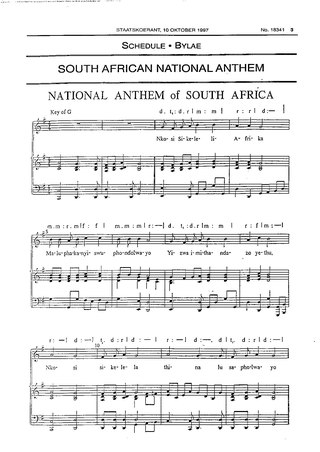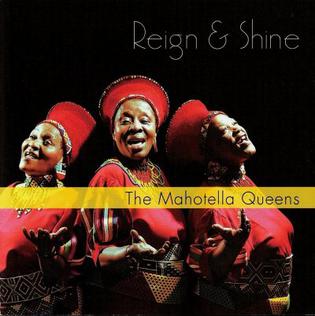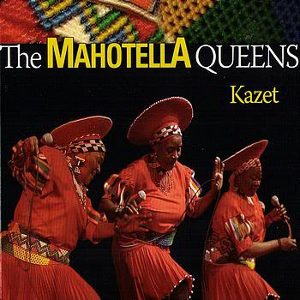
Tanzania, officially the United Republic of Tanzania, is a country in East Africa within the African Great Lakes region. It is bordered by Uganda to the northwest; Kenya to the northeast; the Indian Ocean to the east; Mozambique and Malawi to the south; Zambia to the southwest; and Rwanda, Burundi, and the Democratic Republic of the Congo to the west. According to the 2022 national census, Tanzania has a population of around 62 million, making it the most populous country located entirely south of the equator.

The national anthem of South Africa was adopted in 1997 and is a hybrid song combining extracts of the 19th century Xhosa hymn "Nkosi Sikelel' iAfrika" and the Afrikaans song that was used as the South African national anthem during the apartheid era, "Die Stem van Suid-Afrika", with new English lyrics.

As it is in other countries, the music in Tanzania is constantly undergoing changes, and varies by location, people, settings and occasion. The five music genres in Tanzania, as defined by BASATA are, ngoma, dansi, kwaya, and taarab, with bongo flava being added in 2001. Singeli has since the mid-2000s been an unofficial music of uswahilini, unplanned communities in Dar es Salaam, and is the newest mainstream genre since 2020.

"Stand and Sing of Zambia, Proud and Free" is the national anthem of Zambia. The tune is taken from the hymn "Nkosi Sikelel' iAfrika", which was composed by Xhosa composer Enoch Sontonga, in 1897. The lyrics were composed after Zambian independence to specifically reflect Zambia, as opposed to Sontonga's lyrics, which refer to Africa as a whole.
"Ishe Komborera Africa", also called "Ishe Komborera Zimbabwe", was the Zimbabwean national anthem from 1980 to 1994. It was the country's first national anthem after gaining independence in 1980. It is a translation of 19th-century South African schoolteacher Enoch Sontonga's popular African hymn "Nkosi Sikelel' iAfrika" into Zimbabwe's native Shona and Ndebele languages.

"Rise, O Voices of Rhodesia" was the national anthem of Rhodesia and Zimbabwe Rhodesia between 1974 and 1979. The tune was that of "Ode to Joy", the Fourth Movement from Ludwig van Beethoven's Ninth Symphony, which had been adopted as the official European continental anthem by the Council of Europe in 1972. The music used in Rhodesia was an original sixteen-bar arrangement by Captain Ken MacDonald, the bandmaster of the Rhodesian African Rifles. A national competition was organised by the government to find an appropriate set of lyrics to match the chosen tune, and won by Mary Bloom of Gwelo.

Die Stem van Suid-Afrika, also known as "The Call of South Africa" or simply "Die Stem", was the national anthem of South Africa during the apartheid era. There are two versions of the song, one in English and the other in Afrikaans, which were in use early on in the Union of South Africa alongside God Save the Queen and as the sole anthem after South Africa became a republic. It was the sole national anthem from 1957 to 1994, and shared co-national anthem status with "God Save the King/Queen" from 1938 to 1957. After the end of apartheid, it was retained as a co-national anthem along with "Nkosi Sikelel' iAfrika" until 1997, when a new hybrid song incorporating elements of both songs was adopted as the country's new national anthem, which is still in use.

"Nkosi Sikelel' iAfrika" is a Christian hymn composed in 1897 by Enoch Sontonga, a Xhosa clergyman at a Methodist mission school near Johannesburg.

John Langalibalele Dube OLG was a South African essayist, philosopher, educator, politician, publisher, editor, novelist and poet. He was the founding president of the South African Native National Congress (SANNC), which became the African National Congress in 1923. He was an uncle to Dr Pixley ka Isaka Seme, with whom he founded SANNC. Dube served as the president of SANNC between 1912 and 1917. He was brought to America by returning missionaries and attended Oberlin Preparatory Academy.

Enoch Mankayi Sontonga was a South African composer, who is best known for writing the Xhosa hymn "Nkosi Sikelel' iAfrika", which, in abbreviated version, has been sung as the first half of the national anthem of South Africa since 1994. Previously, it had been the official anthem of the African National Congress since 1925. It was also adopted by South Africa's newly formed northern neighbour, Zimbabwe and translated into Shona, "Ishe Komborera Afrika" from 1980 until 1994.

Following Tanganyika's independence (1961) and unification with Zanzibar (1964), leading to the formation of the state of Tanzania, President Julius Nyerere emphasised a need to construct a national identity for the citizens of the new country. To achieve this, Nyerere provided what has been regarded by some commentators as one of the most successful cases of ethnic repression and identity transformation in Africa.

The National Assembly of Tanzania and the President of the United Republic of Tanzania make up the Parliament of Tanzania. The current Speaker of the National Assembly is Tulia Ackson, who presides over a unicameral assembly of 393 members.

Reign & Shine is a 2005 album by the South African mbaqanga group the Mahotella Queens. The album was a break from their usual mgqashiyo music, focusing on three-part vocal harmonies and percussion, with electric guitar and bass only appearing on some tracks. The album featured new compositions such as "Amazemula" ("Monster") and "Ndodana Yolahleko" as well as old favourites like "Town Hall" and "Amabhongo" in addition to the South African national anthem, "Nkosi Sikelel' iAfrika".

Kazet is a 2006 album by the South African mbaqanga group the Mahotella Queens. The album was a compilation of recordings that had recently been recorded in South Africa and in Paris, and included the South African national anthem "Nkosi Sikelel' iAfrika" in addition to new compositions such as "Amazemula" ("Monster"), "Nomshloshazana" and "Ubusuku Nemini" and classics like "Kazet".
"Tanzania Nakupenda Kwa Moyo Wote" is a Swahili-language patriotic song about Tanzania in East Africa. The song's history and authorship is uncertain, but stretches back to the colonial days, when then it was sung as thus "Tanganyika, Tanganyika nakupenda kwa moyo wote."

Samuel Edward Krune Mqhayi was a Xhosa dramatist, essayist, critic, novelist, historian, biographer, translator and poet whose works are regarded as instrumental in standardising the grammar of isiXhosa and preserving the language in the 20th century.

Since unification in 1910, South Africa has used a range of national symbols to identify the country: coats of arms, official seals, flags, national anthems, and floral, bird, animal, and other emblems.
"Aberystwyth" is a hymn tune composed by Joseph Parry, written in 1876 and first published in 1879 in Edward Stephen's Ail Lyfr Tonau ac Emynau. Parry was at the time the first professor and head of the new department of music at the recently founded University College Wales, Aberystwyth, now called Aberystwyth University.

Voice of Hope is a 2014 album by South African opera singer Pumeza Matshikiza. The album was released on Decca Records.
Nkosi is a Nguni word for "king", "chief" and "lord". Nkosi is a common name and surname among Nguni people. Notable people with the surname include:














